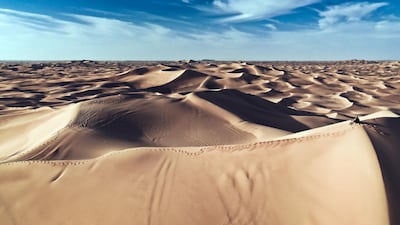Sand dunes “communicate” with one another and even “repel” their downstream neighbours, a new study has found.
Researchers from the University of Cambridge discovered the new form of dune migration by analysing the way turbulence in the air or water, created by one dune, affects how a nearby dune moves.
They built a circular chamber, at the University of Cambridge's Department of Applied Mathematics and Theoretical Physics, to monitor how the dunes moved under certain conditions.
The results are important in infrastructure planning because they could help predict dune movement.
About two metres in diameter and half a metre tall, the apparatus consists of a large circular channel containing water with sand at the base.
To simulate dune movement, two identical piles of sand were made and then flow was created by paddles at the top of the apparatus to move the water around.
The apparatus was made round so the dunes could keep going round and round with no limit on how long the experiment lasted.
There were a number of ideas about how the dunes would interact, including a potential for them to merge with one large dune or bounce off one another like snooker balls. What the experiment showed was unexpected.
Both dunes moved in the direction of the water flow, but the downstream one – the one further from the incoming flow – moved faster initially, increasing the distance between the dunes.
“What we found quite surprising was that even though we put them quite close together at the beginning, over time they started separating from each other as though they didn't like each other,” said Karol Bacik a PhD researcher who carried out much of the experimental work for the study over the past year or so.
"There's communication of a sort between the dunes, directed by the structure of the flow. It's all thanks to the turbulence. The turbulence swirls and curls, allowing this dune to dune feedback. The upstream one signals to the downstream one and makes it move faster.
“If you look at the structure of the flow or the wind around the dunes, you see that it changes once it encounters the upstream dune. It's like a boat – you can see the wake behind it.”
This is shown by "tracer particles", which are particles that have the same density as water, so they move according to the flow of the water, and not gravity.
These demonstrate that particles on the upstream dune move smoothly, as though on a conveyor belt. By contrast, particles on the downstream dune move intermittently, sometimes being swept up by the turbulence.
However, as the dunes become further apart, feedback weakens: the “wake” of the upstream dune has less of an effect on the downstream dune.
As a result, the dunes end up moving at the same speed and the upstream dune is no longer “repelling” the downstream dune.
In the laboratory, it takes about an hour for the dunes to move apart and then begin moving at the same speed. The dunes shift at about two metres per hour, far faster than in natural environments, their movements captured on a high-speed camera.
The findings, reported in the journal Physical Review Letters, are of more than scientific interest: they could help predict the migration of large dunes that may affect roads or other infrastructure – because dunes rarely exist on their own and are, instead, usually surrounded by other dunes.
"It's a fundamental question on the one hand and it's of interest because these dunes move and bury roads or buildings on the ground or affect shipping channels," Mr Bacik said.
“Making a prediction about how they would move is not just an academic nicety. These big dunes move a couple of metres a year, so the landscape changes over decades.
“To plan any action and address these changes, we need ideally a numerical or theoretical model of what the landscape will look like in a few years.”
The scientists, led by Dr Nathalie Vriend, a Royal Society University Research Fellow at the BP Institute within the university, will now look at satellite images, probably including some from the Arabian Peninsula, to see if their laboratory results tally with what happens in the real world.


